Hands On with USB Type C: Reversible USB Connectors
by Joshua Ho on September 11, 2014 9:00 AM EST- Posted in
- Smartphones
- Mobile
- Laptops
- Tablets
- USB-IF
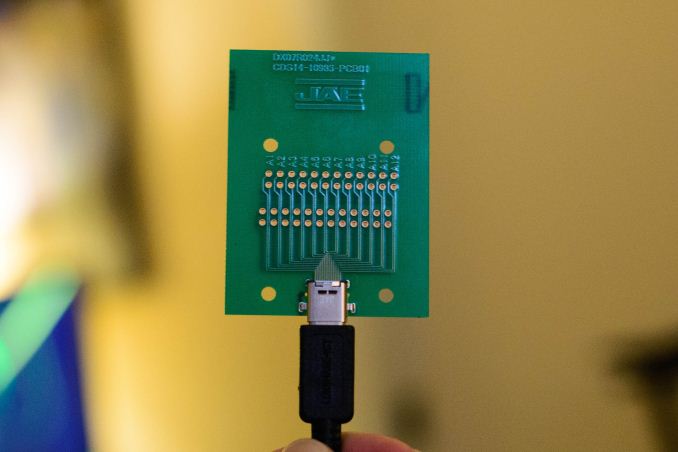
Today, the USB-IF brought me in to see the long-awaited USB Type C cables. We've written about this before, but for those that aren't familiar with this new USB spec, the USB Type C cable and USB 3.1 spec are designed with the future in mind. As a result, there are a lot of new features to talk about. We'll start with the USB 3.1 spec before we get into the Type C connector.
With USB 3.1, we see a few key improvements. Peak throughput goes to 10 Gbps from 5 Gbps, which translates to a peak of 1.25 GB/sec. In a demo of an early controller with two SSDs attached to the system I saw peak throughput of 833 MB/sec. As a side note, I also saw a demo of wireless USB connectivity from smartphone to laptop and laptop to smartphone, which was definitely pretty cool. Getting back to the USB 3.1 spec, USB Power Delivery 2.0 (PD) makes it possible for USB to supply up to 100 watts, and coexists with the BC 1.2 spec that is used in USB power adapters to charge phones so a single port would be able to provide power for both systems. In addition, USB PD 2.0 allows for power to go both ways without changing the direction of the cable, so a laptop would be able to send and receive power from the same port. Finally, USB Type-C extensions mean that it's possible to do all kinds of interesting applications over USB ports, such as sending audio and video data. It's even possible for a USB Type C port to send PCI-E data through the connection for use cases such as a two in one convertible tablet.
This opens up the possibility for a dock scenario where a single cable to the monitor can charge a laptop and also mirror the laptop's display onto the external monitor, and the external monitor would also be able to serve as a USB hub for a keyboard, mouse, headsets, flash drives, and other USB peripherals. While the laptop charging aspect and integrated USB hub in display wasn't demonstrated in the prototype I saw, everything else was fully working as shown in the photo above.
I was also able to get some photos of the cable and receptacle. Unfortunately it took flash to really show the detail in the connector but it definitely will be a great standard for all kinds of applications. While I'm sure that there will be differences in the final product, the reversible plug works just like expected and could be quickly inserted from behind the back. The USB-IF believes that this standard will show up in products shipping in 2015. It does seem that the connector is a bit less compact than microUSB, but the benefits outweigh this increase in size.


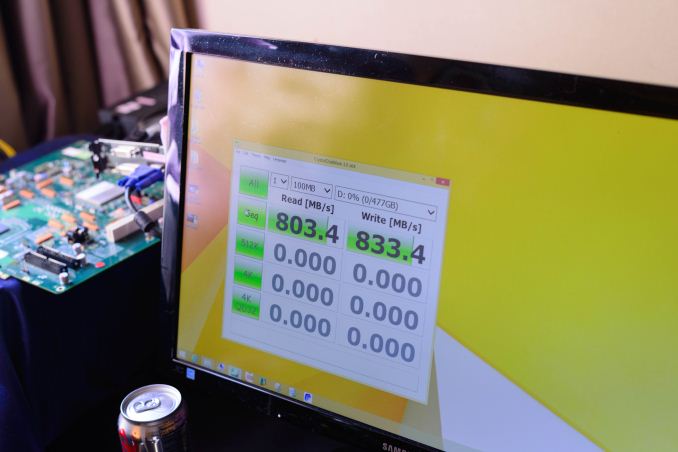

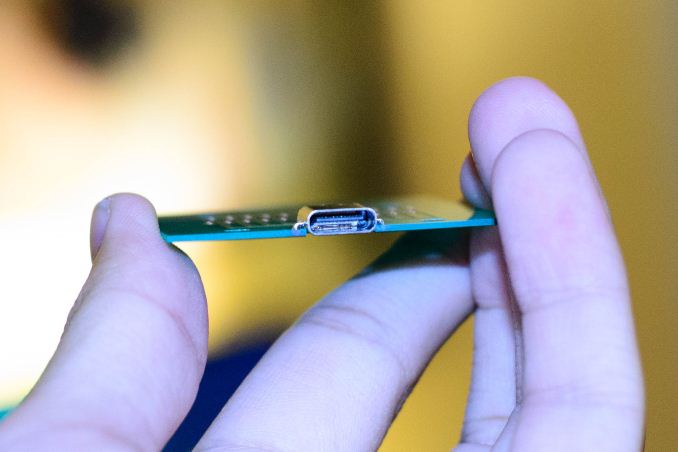
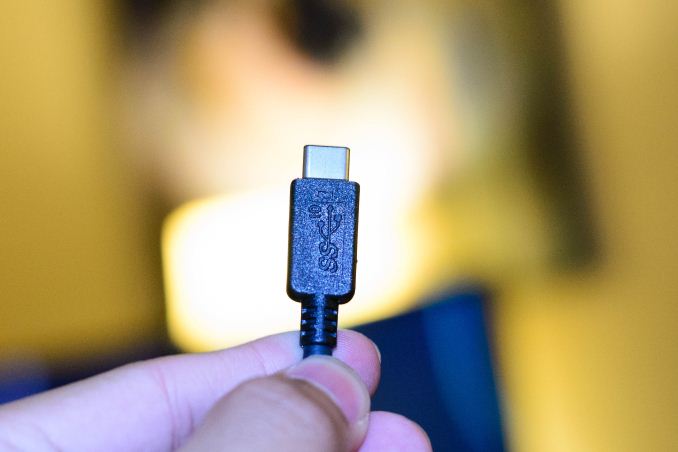
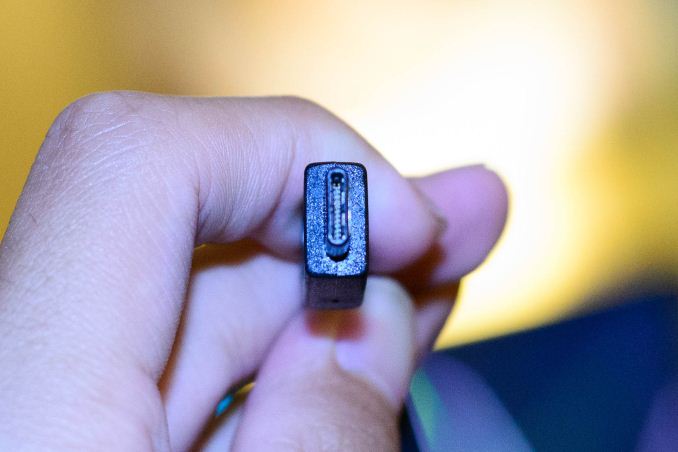








91 Comments
View All Comments
HisDivineOrder - Thursday, September 11, 2014 - link
It's enough to make you wonder why it took Apple making Lightning to get them to realize this was an important thing to do (ie., reversible).Seems obvious. I guess everyone likes saving features to sell later.
Flunk - Thursday, September 11, 2014 - link
They've been working on this for quite a while, since long before "lightning" was released. Standards take a lot longer to get worked out than proprietary ports. The idea that Apple drives every advance in technology is fallacious.JimmaDaRustla - Thursday, September 11, 2014 - link
Yes, and this thing blows the lightning adapter out of the water in terms of power and bandwidth - pretty sure the lightning adapter is slower than their old fat connector because the HDMI adapters have a mini processor in them to decompress video because the adapter couldn't deliver.Anyway, its kind of like Apple Pay - I'm sure people will give them praise for the whole technology, meanwhile Google, payment networks, acquires, EMV, and financial institutes have been working on tokenization for a long time now. Apple just had perfect timing, understood what they had to do with the iPhone and iOS, and used their power to say "1...2...3...JUMP". It is awesome, can't deny that, but to your point, we can't take everything from Apple at face value.
ivat - Thursday, September 11, 2014 - link
No. Thunderbolt 2, available right now in any Retina Macbook Pro and the Mac Pro is 20 Gbps, twice USB 3.1's 10 Gbps [1]. USB 3.1 won't be in products until 2015 (see article). In 2015, Thunderbolt 3 will come out and will be 40 Gbps [2].You are referring to the Thunderbolt 1 HDMI adapter which down sampled the video because it was bandwidth limited. Thunderbolt 1 was 10 Gbps, just like USB 3.1.
[1] - http://www.anandtech.com/show/7049/intel-thunderbo...
[2] - http://www.extremetech.com/computing/181099-next-g...
willis936 - Thursday, September 11, 2014 - link
Firstly the comparison is between the lighting connected and the USB-C connector and there's no contest. The USB-C wins where it matters by a fair margin.Secondly thunderbolt is an Intel invention, not an Apple one. Apple was an early adopter.
WinterCharm - Tuesday, September 16, 2014 - link
Actually, Thunderbolt came as a partnership between Intel and Apple. Apple approached them with the technology, and asked Intel to build it so that it wouldn't go the way of FireWire.C@illou - Friday, September 12, 2014 - link
Sorry but this thread is about Lightning, which is the last iPhone/iPad connector, and not about Thunderbold, which of course blows out USB 3.1 in term of speed and video signal capabilities. They're talking about a reversible connector, which Thunderbolt is not.(And I don't think Thunderbold / Mini Display Port to HDMI was downsampling anything, at least, not at 1080p)
Laststop311 - Saturday, September 13, 2014 - link
thunderbolt 2 rly didnt add extra bandwidth. thunderbolt 1 has 2 10gbit channels but if ur only using 1 it still runs at 10gbps thunderbolt 2 allows you to bond the channels together to give you 20gbps but if u are using both channels its still 10 gbps.iwod - Thursday, September 11, 2014 - link
Are you confusing USB 3.1 and Type C Connector, which are not the same thing. ( Although they could coexist )JarredWalton - Thursday, September 11, 2014 - link
My problem with this connector is the same problem I have with micro-USB: the connectors are too fragile! I've had quite a few USB to micro-USB cables go bad on me, where wiggling the connector in my phone (or even touching it) can cause a disconnect to happen. From that standpoint, I think the Lightning connector looks a lot more robust. This is a case where smaller isn't always better -- the big USB connectors rarely gave me any trouble, mini-USB was pretty reliable, but micro-USB has been far more flaky in my experience. Anyone else have that problem?